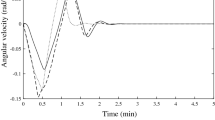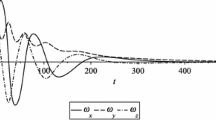Abstract
This paper introduces a new class of finite-time feedback controllers for rigid-body attitude dynamics subject to full actuation. The control structure is Lyapunov-based and is designed to regulate the configuration from an arbitrary initial state to any prescribed final state within user-specified finite transfer-time. A salient feature here is that the synthesis of the control structure is explicit, i.e., given the transfer-time time, the feedback-gains are explicitly stated to satisfy the convergence specifications. A major contrast between this work and others in the literature is that instead of resorting to feedback-linearization (to get to the so-called normal form), our approach efficiently marries the process of designing time-varying feedback gains with the logarithmic Lyapunov function for attitude kinematics based on the Modified Rodrigues Parameters representation. Saliently, this finite-time solution extends nicely for accommodating trajectory tracking objectives and possesses robustness with respect to bounded external disturbance torques. Numerical simulations are performed to test and validate the performance and robustness features of the new control designs.




Similar content being viewed by others
Notes
We use the property \(a\boldsymbol {b}^{T}\boldsymbol {c} \leq \frac {1}{2}\left (\begin {array}{llll} a^{2} ||\boldsymbol {b}||^{2} + ||\boldsymbol {c}||^{2} \end {array}\right ), \forall a \in \mathbb {R}_{>0}, \boldsymbol {b} \in \mathbb {R}^{n}, \boldsymbol {c} \in \mathbb {R}^{n}, n \in \mathbb {Z}_{>0}\).
References
Athans, M., Falb, P.L.: Optimal Control: An Introduction to the Theory and its Applications. Courier Corporation (2013)
Slotine, J.-J.E., Li, W., et al.: Applied Nonlinear Control, vol. 199. Prentice Hall, Englewood Cliffs (1991)
Bhat, S.P., Bernstein, D.S.: Finite-time stability of continuous autonomous systems. SIAM J. Control. Optim. 38(3), 751–766 (2000)
Song, Y., Wang, Y., Holloway, J., Krstic, M.: Time-varying feedback for regulation of normal-form nonlinear systems in prescribed finite time. Automatica 83, 243–251 (2017)
Bryson, A., Ho, Y.-C.: Applied Optimal Control: Optimization, Estimation, and Control (Revised Edition). Taylor & Francis, Levittown (1975)
Tsiotras, P.: New Control Laws for the Attitude Stabilization of Rigid Bodies. Automatic Control in Aerospace 1994 (Aerospace Control’94), pp. 321–326. Elsevier (1995)
Junkins, J.L., Akella, M.R., Robinett, R.D.: Nonlinear adaptive control of spacecraft maneuvers. J. Guid. Control Dyn. 20(6), 1104–1110 (1997)
Shuster, M.D.: A survey of attitude representations. Navigation 8(9), 439–517 (1993)
Khalil, H.K.: Nonlinear Systems. New Jewsey, Prentice Hall (2002)
Wen, J.-Y., Kreutz-Delgado, K.: The attitude control problem. IEEE Trans. Autom. control 36(10), 1148–1162 (1991)
Chatuverdi, N., Sanyal, A.K., McClamroch, N.H.: Rigid-body attitude control using rotation matrices for continuous, singularity-free control laws. IEEE Control. Syst. Mag. 31(8), 30–51 (2011)
Cemenska, J.: Sensor Modelling and Kalman Filtering Applied to Satellite Attitude Determination. University of California at Berkeley, PhD thesis (2004)
Author information
Authors and Affiliations
Corresponding author
Additional information
Publisher’s Note
Springer Nature remains neutral with regard to jurisdictional claims in published maps and institutional affiliations.
Appendices
Appendix A
In this section, we prove that if:
then \(\mu ^{\alpha _{1}} \boldsymbol {\sigma } \in L_{\infty }, \forall \alpha _{1} \in \mathbb {R}\).
Starting from Eq. 55, we use the definition \(\bar {\mu }(t) \triangleq \mu (t) - 1\) to get:
where \(\alpha _{2} \triangleq V_{0}(0)e^{kt_{f}} > 0\).
Defining \(\beta (t) \triangleq \exp \left [\begin {array}{llll} -kt_{f}\cdot \mu (t) \end {array}\right ]\), it follows that:
In order to show that the signal \(f(t) \triangleq ||\mu ^{\alpha _{1}}(t)\boldsymbol {\sigma }(t)||^{2}\) is bounded, we need to evaluate the limit as t → tf. Taking the limit on both sides:
The above limit can be rewritten as:
Assuming that λ < 2α1, Lemmas 1 and 2 are used to prove that the right-hand side of Eq. 59 is equal to zero, implying that \(||\mu ^{\alpha _{1}}(t)\boldsymbol {\sigma }(t)||^{2} \in L_{\infty }, \forall \alpha _{1} > \lambda /2\). In addition, since \(||\mu ^{\eta _{1}}(t)\boldsymbol {\sigma }(t)||^{2} \leq ||\mu ^{\eta _{2}}(t)\boldsymbol {\sigma }(t)||^{2}\), for η1 ≤ η2, then \(||\mu ^{\alpha _{1}}(t)\boldsymbol {\sigma }(t)||^{2} \in L_{\infty }, \forall \alpha _{1} \in \mathbb {R}\).
Lemma 1
For any finite real constantsα1≠ 0,α2 > 0,γ1 > 0,γ2 > 0, then:
Proof
Making the substitution \(y = x^{-\gamma _{2}}\), then:
where \(\gamma _{3} \in \mathbb {N} \triangleq \lfloor \gamma _{1}/\gamma _{2} \rfloor \) and \(\gamma _{4} \in [0, 1) \triangleq \gamma _{1}/\gamma _{2} - \gamma _{3}\).
One can notice that the limit in Eq. 61 is a product of zero with ∞, which can be solved for by using L’Hospital’s rule. Defining \(\gamma _{5} \triangleq \gamma _{3} + \gamma _{4}\), we apply L’Hospital’s rule γ3 times, leading to:
If γ4 = 0, then the proof is complete. However, if γ4 ∈ (0, 1), then we need to use L’Hospital’s rule one more time:
Lemma 2
For any finite real constantsα1 > 0,α2 > 0, and0 < γ1 ≤ γ2 < γ3,then\(\lim _{x \to \infty }f(x) = 0\),where:
Proof
Defining \(y \triangleq x^{-\gamma _{3}}\), we have that \(y^{-\gamma _{4}} = x^{\gamma _{1}}\), and \(y^{\gamma _{5}} = x^{-\gamma _{2}}\), where \(\gamma _{4} \triangleq \frac {\gamma _{1}}{\gamma _{3}}\) and \(\gamma _{5} \triangleq \frac {\gamma _{2}}{\gamma _{3}}\). Since 0 < γ1 ≤ γ2 < γ3, then 0 < γ4 ≤ γ5 < 1. The limit can be rewritten as:
For notation simplicity, we define \(\beta (y) \triangleq \exp \left [\begin {array}{llll} -\alpha _{2} y^{-\gamma _{4}} \end {array}\right ]\), leading to:
It is straightforward to see that \(\lim _{y \to 0^{+}}\beta (y) = 0\) and that \(\lim _{y \to 0^{+}}e^{\alpha _{1} y^{\gamma _{5}} \beta (y)} = 1\). Since this limit is a ratio of zero with zero, we can use L’Hospital’s rule to show that the right-hand side of Eq. 66 converges to zero as y → 0+. We define the numerator signal as:
Clearly, it is sufficient to prove that if \(\lim _{y \to 0^{+}}\frac {dn(y)}{dy} = 0\), then
implying that \(\lim _{y \to 0^{+}}f(y) = 0\). Using the notation \(f^{\prime } \triangleq \frac {\partial f}{\partial y}\) the derivative of n(y) is given by:
where γ6 > 0 is defined as \(\gamma _{6} \triangleq 1 - \gamma _{5}\). Given that
for \(\gamma _{7} \triangleq 1 + \gamma _{4} > 1\), we can substitute Eq. 70 into Eq. 69:
One should note that since γ7 > 1 and 0 < γ5 < 1, then γ7 − γ5 > 0. Using Lemma 1 and the definition \(\beta (y) \triangleq \exp \left [\begin {array}{llll} -\alpha _{2} y^{-\gamma _{4}} \end {array}\right ]\), then:
Remembering that \(\lim _{y \to 0^{+}}\beta (y) = 0\), and that \(\lim _{y \to 0^{+}}e^{\alpha _{1} y^{\gamma _{5}}\beta (y)} = 1\), then \(\lim _{y \to 0^{+}} n^{\prime }(y) = 0\), which implies that \(\lim _{x \to \infty }f(x) = 0\).
Appendix B
In this section, we show that the inequality
for a constant \(\bar {V} > 0\), implies that μλ/2σ ∈ L∞ and that \(\lim _{t \to t_{f}}\mu ^{\rho }(t)\boldsymbol {\sigma }(t) = 0, \forall \rho < \lambda /2\).
Starting from Eq. 73, we have that:
In order to show that the signal \(f(t) \triangleq ||\mu ^{\lambda /2}(t)\boldsymbol {\sigma }(t)||^{2}\) is bounded, we need to evaluate the limit as t → tf. Taking the limit on both sides:
Assuming λ > 0, the above limit can be rewritten as:
Defining \(\xi (t) \triangleq \mu ^{-\lambda }(t)\), we have that:
Since the above limit is a ratio of zero with zero, we can use L’Hospital’s rule:
Therefore, \(f(t) \triangleq ||\mu ^{\lambda /2}(t)\boldsymbol {\sigma }(t)||^{2}\) is bounded, i.e., μλ/2σ ∈ L∞. Also, since \(||\mu ^{\lambda /2}(t)\boldsymbol {\sigma }(t)||^{2} \leq \bar {V}\), then for any 𝜖 > 0 and constant ρ such that 2𝜖 + ρ = λ/2 we have that \(||\mu ^{\rho }\boldsymbol {\sigma }(t)||^{2} \leq \mu ^{-\epsilon }(t)\bar {V}\), implying that \(\lim _{t \to t_{f}} ||\mu ^{\rho }\boldsymbol {\sigma }(t)||^{2} = 0\).
Rights and permissions
About this article
Cite this article
de Almeida, M.M., Akella, M.R. New Class of Attitude Controllers Guaranteed to Converge within Specified Finite-Time. J Astronaut Sci 67, 552–570 (2020). https://doi.org/10.1007/s40295-019-00180-5
Published:
Issue Date:
DOI: https://doi.org/10.1007/s40295-019-00180-5




